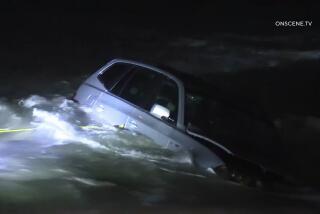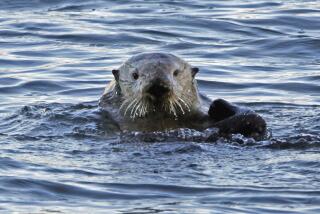Walter the sea lion pup is saved, but California rescuers are overwhelmed

Rehabilitation centers in California are getting a deluge of ailing sea lions, and it’s overwhelming resources.
Marina del Rey residents were surprised when a sea lion pup wandered into their apartment complex.
They named him Walter.
But getting help for Walter when he was spotted on Monday wasn’t easy. He’s just one sick pup amid a deluge of ailing sea lions currently overwhelming marine mammal rehabilitation centers in California.
Rescuer Peter Wallerstein said he’d received calls about the sea lion before the animal wandered into the complex. But as long as the pup was out of the way of people, Walter was on the back burner for rescue.
“But then this lady called me and said he was up in the parking lot. So I responded immediately because I knew it would be bad for him,” Wallerstein said.
There are so many strandings right now, Wallerstein said, “we cannot possibly pick up all the pups. People just don’t seem to understand.”
The same day in Malibu, Roxanne McCann was taking a walk along Las Flores Beach a little after noon when she saw a thin sea lion pup.
“The poor little thing looked like it was struggling,” she said. “Everybody thinks it’s a cute story. People don’t understand that they’re not well.”
A neighbor’s call to a rescue hot line didn’t produce quick results.
“The recording said please have patience and ... they were not going to be able to respond immediately,” McCann said. The neighbor later received a message saying there would be no action that day.
California Wildlife performs marine mammal rescues in the Malibu area. A recording at the emergency line cautions that the “extreme high call volume” means animals may not be rescued on the day they’re spotted. “We also may not be able to return every phone call of a reported marine mammal.”
Wallerstein is in much the same situation. His two-person Marine Animal Rescue team, which covers rescues for a large chunk of L.A. County, gets more than two dozen calls a day, he said.
“There are tons of sea lions on beaches, and people just aren’t tolerant with our lack of response,” he said. “They think it’s a lack of caring, and it’s not. We care very deeply about the animals.”
He says right now his team is limited to three sea lion rescues a day, capped because the San Pedro center where he delivers the animals is packed.
David Bard, operations director at the Marine Mammal Care Center, said the center recently expanded, adding two new enclosures, but there’s a record number of sick animals.
The center is now accepting three animals daily from each of three rescue agencies.
When stranding numbers “exceed the size, space and/or resource limitations of a facility, NOAA Fisheries will limit new admissions of animals,” he said.
“This is a circumstance that all [marine mammal] rehab centers are facing as they reach the physical limits to the number of animals that they can safely and realistically treat,” Bard said.
Staff members are working long hours to care for patients, he said, and efforts are underway to beef up staff, including paid internships.
On Tuesday, nearly a dozen healthy sea lions were released at a Southern California beach. It’s an upbeat event for those who rehabilitate the sick animals. But it also underlines the disturbingly high number of strandings of California sea lions.
The pups released Tuesday at White Point Beach in San Pedro were about 7 months old. Rescued in January, they are just a few among an alarming number of sick, abandoned sea lions that have shown up on California beaches in 2015.
Malibu resident McCann is a photographer who has taken pictures of sea lion pups for the Malibu Times. She recalled on Tuesday another very bad year for sea lion strandings. In 2013, there was an Unusual Mortality Event declared by the National Marine Fisheries Service.
Such events happen when there is an unexpected number of strandings and a significant die-off of a marine mammal population.
“When it started happening a couple of years ago, we thought the sea lions were just lost,” she said. “People said, ‘We better point it back to the ocean because it’s just lost its way.’
“People were chasing them back into the water thinking they were helping, but the poor things were just too weak.”
Although no Unusual Mortality Event was declared in 2014, there were again record numbers of sea lions at some California rehab centers.
During the Unusual Mortality Event of 2013, Bard said, the San Pedro center was treating two or three times as many California sea lions as normal. But the numbers in 2015 so far are two times what they were in 2013, he said.
“We have well over 100 in house now,” Bard said.
Wallerstein said he’d been performing marine mammal rescues for 29 years and “for January and February, it’s the highest number of rescues I’ve ever seen.”
He made a total 430 rescues in the 2013 UME year; in January and February 2013, he performed 25 rescues.
So far this year, he’s rescued 117 marine mammals.
A team of scientists recently went to the Channel Islands, where most of America’s sea lions breed, hoping to find clues to the strandings. They are expected to announce their findings this month.
Follow me at @AmyTheHub
More to Read
Start your day right
Sign up for Essential California for news, features and recommendations from the L.A. Times and beyond in your inbox six days a week.
You may occasionally receive promotional content from the Los Angeles Times.






